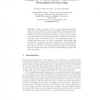133 search results - page 9 / 27 » Predicting Future Decision Trees from Evolving Data |
ACIIDS
2010
IEEE
13 years 9 months ago
2010
IEEE
Abstract. A genetic algorithm is used to learn a non-deterministic Petri netbased model of non-linear gene interactions, or statistical epistasis. Petri nets are computational mode...
CEC
2009
IEEE
13 years 10 months ago
2009
IEEE
—When performing predictive data mining, the use of ensembles is known to increase prediction accuracy, compared to single models. To obtain this higher accuracy, ensembles shoul...
ISMB
1993
13 years 8 months ago
1993
Weintroduce a parallel approach, "DT-SELECT," for selecting features used by inductive learning algorithms to predict protein secondary structure. DT-SELECTis able to ra...
ADMA
2009
Springer
13 years 10 months ago
2009
Springer
Consider a scenario in which a smart phone automatically saves the user’s positional records for personalized location-based applications. The smart phone will infer patterns of ...
EXPERT
2007
13 years 7 months ago
2007
Prediction is an important component in a variety of domains. Intelligent systems that can predict future events are better enabled to make more informed, and therefore more relia...

